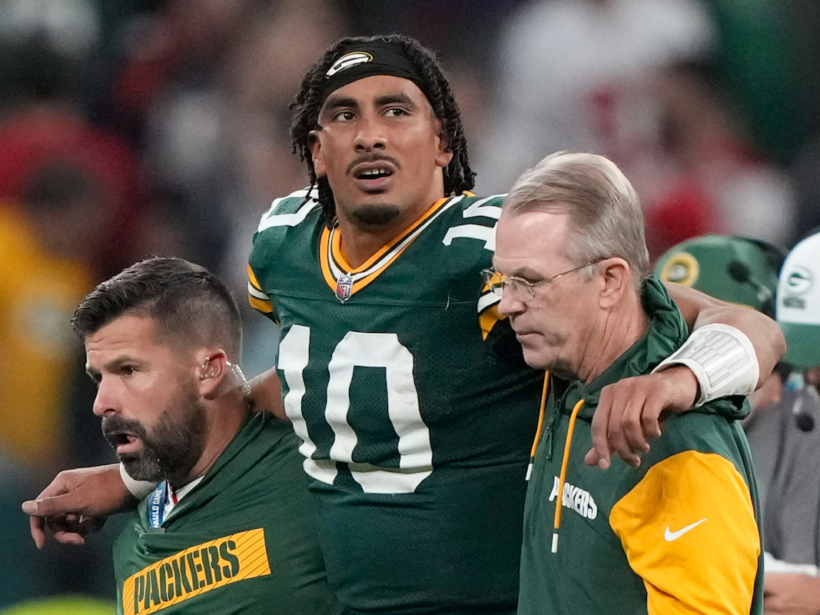The Green Bay Packers and Minnesota Vikings game this past Sunday presented a fascinating tactical challenge. Entering the matchup, there was a notable discrepancy in quarterback Jordan Love’s performance against different defensive schemes. Since the Packers’ bye week, Love had ranked first in the NFL in EPA (Expected Points Added) per play against zone coverage but only 25th against man coverage. This set the stage for an intriguing chess match with Vikings defensive coordinator Brian Flores, who is known for his adaptability and creative scheming.

Flores, who typically employs a zone-heavy defensive approach, had started incorporating more man coverage in recent games. The key question leading into the contest was whether Flores would stick to his bread-and-butter zone coverage or lean more heavily into man coverage to exploit Love’s struggles. Ultimately, Flores chose to deploy a man-heavy scheme, and the decision paid off. Early in the game, the Vikings successfully disrupted the Packers’ offensive rhythm, holding them in check after five consecutive games of scoring 30 points or more.
“They played a little more man than we were anticipating,” Packers head coach Matt LaFleur acknowledged after the game. “They had shown that a couple of games, but we didn’t think we’d see it here. That’s part of why we got off to a slow start. We’ve got to be able to adjust quicker and have plays ready to attack that coverage. That falls squarely on my shoulders.”
LaFleur’s admission underscores a critical vulnerability in the Packers’ offense. While Jordan Love has shown he can excel against zone defenses, the struggles against man coverage are becoming a glaring issue. In high-stakes playoff scenarios, where defensive coordinators craft ultra-specific game plans, such weaknesses are ripe for exploitation. Unless the Packers address this issue, opposing teams will continue to target their inability to consistently beat man coverage.

Jordan Love, for his part, was candid about the team’s shortcomings. “When they’re playing man coverage, it comes down to winning that one-on-one as a receiver. As a quarterback, you’ve got to have great ball placement and make plays,” Love explained. “It’s one-on-one coverage, and guys have to go win. We didn’t do a good enough job at that today, but it’s not on one guy. It’s a whole team thing. There’s a lot we’ll look back on in film, and we’ll need to clean it up and figure out a way to win against that coverage.”
The task ahead is daunting. To beat man coverage consistently, receivers need to excel at separation and physicality, while the quarterback must deliver precise throws. Currently, the Packers’ young receiving corps has struggled to prove they can consistently win these individual matchups. The absence of Christian Watson, sidelined with a knee injury, has only exacerbated the problem, but even with Watson in the lineup earlier this season, the Packers’ struggles against man coverage were evident.
The Packers are running out of time to find solutions. With no immediate help coming from personnel changes, the team must look inward to improve execution. This might involve refining route concepts, emphasizing quick releases, or finding creative ways to scheme receivers open against tight man coverage. However, these adjustments take time and repetition, both of which are in short supply as the playoffs approach.
In the postseason, every weakness is magnified, and teams that fail to adapt are often sent home early. The Packers’ inability to beat man coverage isn’t just a regular-season quirk—it’s a potential Achilles’ heel that could define their playoff fate. While Jordan Love has shown promise in his first full season as a starter, his development must include finding ways to navigate this challenge. Similarly, the coaching staff will need to devise strategies that put their players in positions to succeed against aggressive man-to-man defenses.
The Packers’ schedule offers limited opportunities to experiment before the stakes increase. If the team hopes to make a deep playoff run, they must address this issue immediately. Time is ticking, and the path to postseason success will demand both tactical creativity and execution under pressure. Whether they can rise to the occasion remains to be seen, but one thing is clear: solving the man-coverage puzzle is no longer optional—it’s essential.






